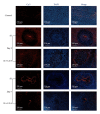An Immunomodulatory Protein (Ling Zhi-8) from a Ganoderma lucidum Induced Acceleration of Wound Healing in Rat Liver Tissues after Monopolar Electrosurgery
- PMID: 24883073
- PMCID: PMC4026841
- DOI: 10.1155/2014/916531
An Immunomodulatory Protein (Ling Zhi-8) from a Ganoderma lucidum Induced Acceleration of Wound Healing in Rat Liver Tissues after Monopolar Electrosurgery
Abstract
The purpose of this study was to investigate the effect of an immunomodulatory protein (Ling Zhi-8, LZ-8) on wound healing in rat liver tissues after monopolar electrosurgery. Animals were sacrificed for evaluations at 0, 3, 7, and 28 days postoperatively. It was found that the wound with the LZ-8 treatment significantly increases wound healing. Western blot analysis clearly indicated that the expression of NF-κB was decreased at 3, 7, and 28 days when liver tissues were treated with LZ-8. Moreover, caspase-3 activity of the liver tissue also significantly decreases at 7 and 28 days, respectively. DAPI staining and TUNEL assays revealed that only a minimal dispersion of NF-κB was found on the liver tissue treated with LZ-8 at day 7 as compared with day 3 and tissues without LZ-8 treatment. Similarly, apoptosis was decreased on liver tissues treated with LZ-8 at 7 days when compared to the control (monopolar electrosurgery) tissues. Therefore, the analytical results demonstrated that LZ-8 induced acceleration of wound healing in rat liver tissues after monopolar electrosurgery.
Figures








Similar articles
-
Ling Zhi-8, a fungal immunomodulatory protein in Ganoderma lucidum, alleviates CPT-11-induced intestinal injury via restoring claudin-1 expression.Aging (Albany NY). 2023 May 5;15(9):3621-3634. doi: 10.18632/aging.204695. Epub 2023 May 5. Aging (Albany NY). 2023. PMID: 37155145 Free PMC article.
-
Pathological Changes in APP/PS-1 Transgenic Mouse Models of Alzheimer's Disease Treated with Ganoderma Lucidum Preparation.Zhongguo Yi Xue Ke Xue Yuan Xue Bao. 2017 Aug 20;39(4):552-561. doi: 10.3881/j.issn.1000-503X.2017.04.015. Zhongguo Yi Xue Ke Xue Yuan Xue Bao. 2017. PMID: 28877835 English.
-
Molecular cloning of a cDNA and a gene encoding an immunomodulatory protein, Ling Zhi-8, from a fungus, Ganoderma lucidum.J Biol Chem. 1991 Feb 5;266(4):2486-93. J Biol Chem. 1991. PMID: 1990000
-
Prevention of dextran sulfate sodium-induced mouse colitis by the fungal protein Ling Zhi-8 via promoting the barrier function of intestinal epithelial cells.Food Funct. 2021 Mar 1;12(4):1639-1650. doi: 10.1039/d0fo02604b. Food Funct. 2021. PMID: 33481975
-
Anti-osteoporosis Effect of Ganoderma (Lingzhi) by Inhibition of Osteoclastogenesis.Adv Exp Med Biol. 2019;1182:263-269. doi: 10.1007/978-981-32-9421-9_11. Adv Exp Med Biol. 2019. PMID: 31777023 Review.
Cited by
-
Ganoderma lucidum Immune Modulator Protein rLZ-8 Could Prevent and Reverse Bone Loss in Glucocorticoids-Induced Osteoporosis Rat Model.Front Pharmacol. 2020 May 19;11:731. doi: 10.3389/fphar.2020.00731. eCollection 2020. Front Pharmacol. 2020. PMID: 32508652 Free PMC article.
-
Recombinant Lactococcus lactis Expressing Ling Zhi 8 Protein Ameliorates Nonalcoholic Fatty Liver and Early Atherogenesis in Cholesterol-Fed Rabbits.Biomed Res Int. 2020 Jan 27;2020:3495682. doi: 10.1155/2020/3495682. eCollection 2020. Biomed Res Int. 2020. PMID: 32047809 Free PMC article.
-
Ganoderma lucidum-From Ancient Remedies to Modern Applications: Chemistry, Benefits, and Safety.Antioxidants (Basel). 2025 Apr 25;14(5):513. doi: 10.3390/antiox14050513. Antioxidants (Basel). 2025. PMID: 40427395 Free PMC article. Review.
-
Development of Ling-zhi industry in China - emanated from the artificial cultivation in the Institute of Microbiology, Chinese Academy of Sciences (IMCAS).Mycology. 2016 Apr 28;7(2):74-80. doi: 10.1080/21501203.2016.1171805. eCollection 2016. Mycology. 2016. PMID: 30123618 Free PMC article.
-
Encouraging Tactics with Genetically Modified Probiotics to Improve Immunity for the Prevention of Immune-Related Diseases including Cardio-Metabolic Disorders.Biomolecules. 2022 Dec 21;13(1):10. doi: 10.3390/biom13010010. Biomolecules. 2022. PMID: 36671395 Free PMC article.
References
-
- Liboon J, Funkhouser W, Terris DJ. A comparison of mucosal incisions made by scalpel, CO2 laser, electrocautery, and constant-voltage electrocautery. Otolaryngology—Head and Neck Surgery. 1997;116(3):379–385. - PubMed
-
- Carew JF, Ward RF, LaBruna A, Torzilli PA, Schley WS. Effects of scalpel, electrocautery, and CO2 and KTP lasers on wound healing in rat tongues. The Laryngoscope. 1998;108(3):373–380. - PubMed
-
- Pearce JA. Electrosurgery. New York, NY, USA: John Wiley & Sons; 1986.
-
- Maness WL, Rober FW, Clark RE, Cataldo E, Haddad AW. Tissue damage from electrosurgical power output variations in hamster tongues. The Journal of Prosthetic Dentistry. 1979;42(4):456–460. - PubMed
-
- Maness WL, Roeber FW, Clark RE, Cataldo E, Riis D, Haddad AW. Histologic evaluation of electrosurgery with varying frequency and waveform. The Journal of Prosthetic Dentistry. 1978;40(3):304–308. - PubMed
LinkOut - more resources
Full Text Sources
Other Literature Sources
Research Materials

